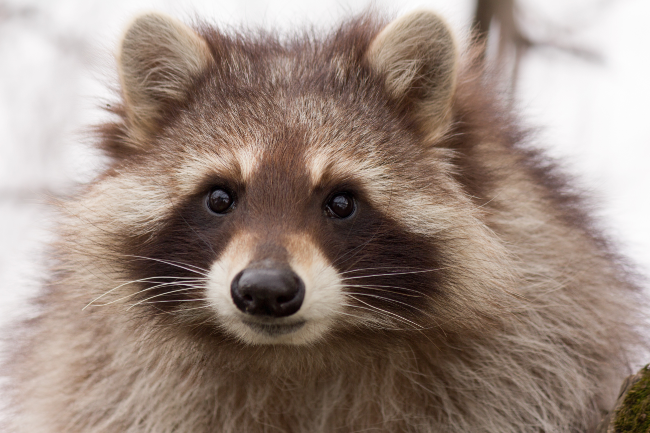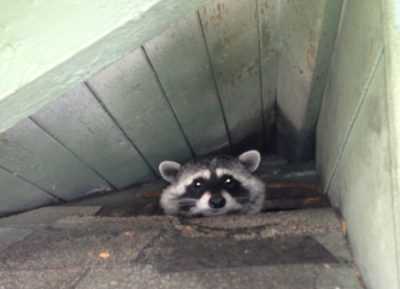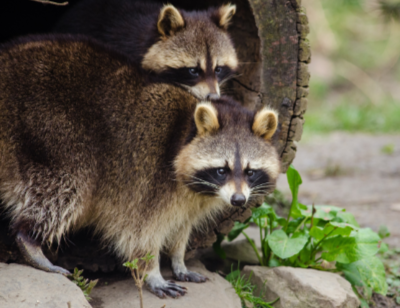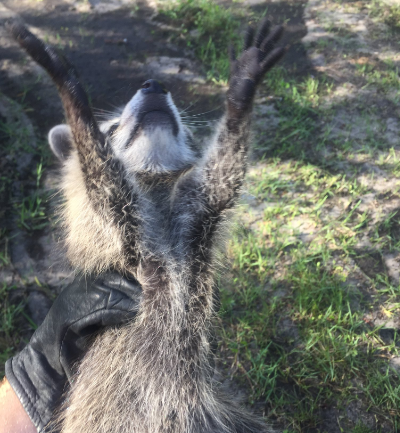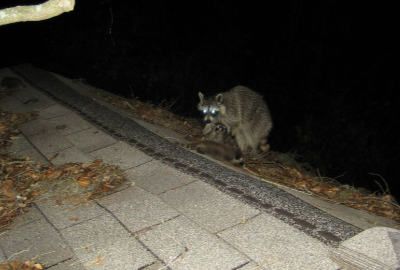Description
Raccoons are some of the most common nocturnal mammals in North America. They are predominantly found in the wooded eastern parts of the United States.
Besides the native raccoons found in the north, you can find six other species in tropical islands. Raccoons are intelligent and have nimble hands that they can use to turn doorknobs, open latches, swim, and climb.
Besides that, they are fast and can run at a speed of more than 10 miles per hour. With their agile paws, raccoons can cause damage to roofs, houses, and yards that can cost homeowners thousands of dollars per year in terms of repairs.
Raccoons are distinct animals. Therefore, there are plenty of ways you can use to identify them.
Appearance
The most distinguishing physical characteristics of raccoons are their grey to brown fur, black coloring, or mask around their small eyes and a ringed bushy tail.
Other characteristics include:
- Short legs, flat feet, and stout bodies.
- Grey or brown fur covers the body.
- Erect forward-pointing rounded ears.
- Snout-like nose.
- About 2-3 feet long.
- About 9-10 inches in height.
- A stripe of black fur extending from the forehead to the nose.
- Black paws resembling human hands with five toes.
- Walks on four paws and can sometimes stand on hind legs.
- Hind limbs are more extended than forelimbs.
- Have short and sharp teeth, with two fangs on both jaws.
- Flexible toes with excellent grasping capabilities. (Grabbing, pulling, and holding).
- Excellent climbing capabilities and can descend either face first or backwards.
- It can be slim (about 10 pounds) in warmer climates or about 30 pounds in colder regions.
- Male is larger than female.
Note: Even though raccoons may look cute and cuddly, they can be quite dangerous to humans. Therefore, take caution while dealing with these bandits.
Diet—What They Eat
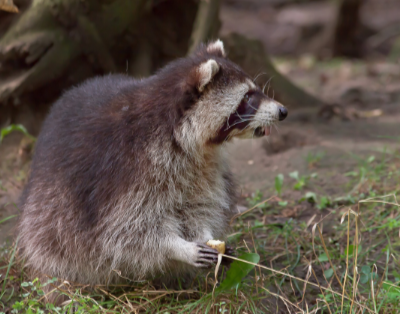
Raccoons are omnivores and therefore thrive on both animal food and plant materials. However, what they eat depends vastly on where they live (habitat).
While in the wild, they eat birds and other animals (mammals). But in most cases, they like easily-hunted meals.
Their favorites include:
- Nuts
- Berries
- Insects
- Eggs
When their den is near a body of water, they prefer feeding on the following:
- Fish
- Shellfish
- Crayfish
- Grubs
- Reptiles
- Amphibians
For the raccoons that live in residential areas, foraging for food in the gardens, trash cans, landfills, and perhaps inside homes is their routine.
During the fall, these pests develop a particular appetite for certain highly nutritious fruits. They include:
- Peaches
- Apples
- Pears
However, they also enjoy a variety of garden vegetables such as:
- Sweet Corn
- Potatoes
- Peas
Behavior (Social, mating, nocturnal)
Raccoons’ behavior depends on the season. They tend to portray different reactions during the winter and summer seasons.
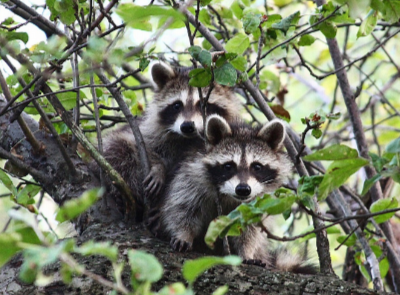
Raccoons are social animals: Males tend to live a solitary life, while females live and eat socially. The males always go out after mating or when their young ones are about to be born.
The female raccoon would then give birth and take care of the young ones on her own. During this time, she can team up with other females and share dens and food.
Female raccoons mature after ten months, after which they become sexually mature and ready to mate. On the other hand, the male has a longer maturity age and may take up to 24 months to mature.
Once mature, raccoons start to fend for themselves and finally leave their mother dens.
Mating:
Raccoons mate only once a year, during the winter season, which may prolong till June.
The male raccoon mates with multiple females within a season, while the female species only mate with one male in a season.Mature females always ovulate recurrently and produce one litter in a year. These sexual relations do not last. The gestation period for a female raccoon is nine weeks, with most births happening during April and May.
A litter may contain one to eight babies, with the majority having three to five young raccoons. Variation in an offspring depends on age, as adult females tend to have more babies than the young ones.
Young raccoons are born weighing three to five ounces, with bodies measuring between 4 to 6 inches long. Their tails are usually short, between 2 – 2.25 inches long.
Raccoons are nocturnal mammals:
They move and feed mostly at night. Weather conditions determine their movements.
In most cases, they move during summer and spring seasons to find food.
Other Raccoon habits include:
Eating habits: They don't choose what to eat. They can consume any type of plant or meat.
Scavengers: They are always after food remains that have been left behind by animals or human beings.
Introverts: Even though raccoons are social animals, males enjoy staying alone. They also like having their territories with less population.
They do not hibernate: Raccoons don't usually hibernate. But they go into the sleeping process called torpor; this slows down their body functions, making them conserve fat and energy.
Unique hands: Raccoons have long and flexible fingers that enable them to hold around, feel, and catch their prey without them looking. The fingers also have claws that allow them to grasp items and climb trees.
Seasonal behavior
During winter: raccoons tend to slow down their activities to a state known as torpor.
Their bodies’ metabolism slows down as they spend most of their time sleeping.
This kind of semi-hibernation allows them to conserve energy and fat.During summer and spring: raccoons become very active. They move from one point to another, with many vocalizations. Below are some of the sounds that they may produce.
- Whistling
- Hissing
- Growling
- Snarling
- Screaming
Habitat (Natural and Urban)
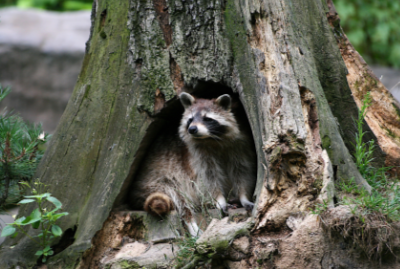
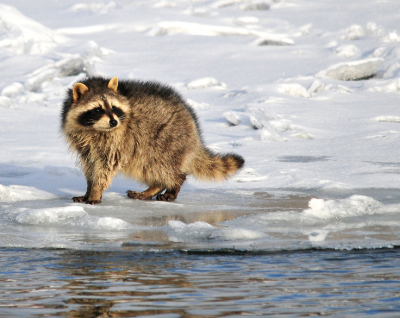
Raccoons' various stages of growth always determine habitats. They are very adaptive and tend to live both in the forest and urban areas.
Natural Habitats
Raccoons tend to live in forests, near marshes, streams, rivers, and other kinds of water sources. While in this kind of habitat, most of their food comes from aquatic creatures including:
- Turtles
- Crayfish
- Snails
They also consume plant materials such as:
- Corn
- A variety of fruits and vegetables
- Nuts
Besides that, raccoons don’t create their dwellings. However, they prefer living in areas such as: Under rocks, underground tunnels, tree cavities, and dens abandoned by other animals.
In Urban Areas
While in urban areas, raccoons tend to live in home-made farms and residential gardens.
They have adopted the city life by feeding on garbage, insects, as well as plants from the home-made gardens and fields.
When it comes to shelter, raccoons seek refuge in empty structures and abandoned buildings.
But at times, they can bulldoze into your chimney and craft a comfortable home.


